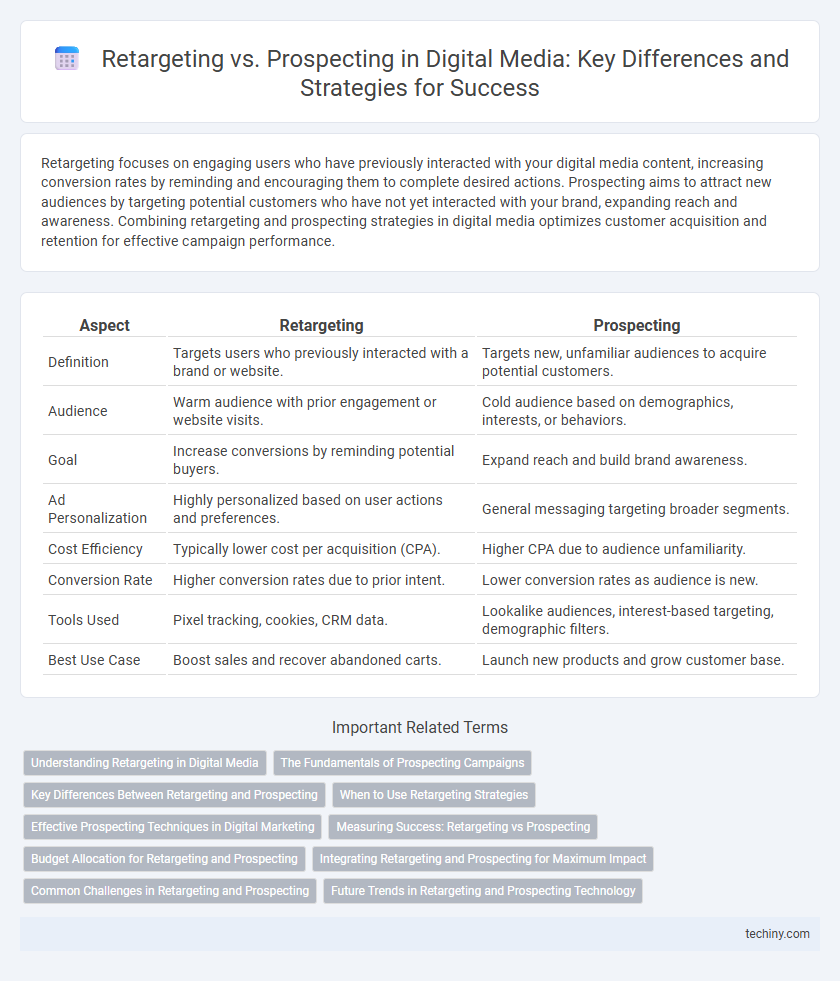Retargeting focuses on engaging users who have previously interacted with your digital media content, increasing conversion rates by reminding and encouraging them to complete desired actions. Prospecting aims to attract new audiences by targeting potential customers who have not yet interacted with your brand, expanding reach and awareness. Combining retargeting and prospecting strategies in digital media optimizes customer acquisition and retention for effective campaign performance.
Table of Comparison
| Aspect | Retargeting | Prospecting |
|---|---|---|
| Definition | Targets users who previously interacted with a brand or website. | Targets new, unfamiliar audiences to acquire potential customers. |
| Audience | Warm audience with prior engagement or website visits. | Cold audience based on demographics, interests, or behaviors. |
| Goal | Increase conversions by reminding potential buyers. | Expand reach and build brand awareness. |
| Ad Personalization | Highly personalized based on user actions and preferences. | General messaging targeting broader segments. |
| Cost Efficiency | Typically lower cost per acquisition (CPA). | Higher CPA due to audience unfamiliarity. |
| Conversion Rate | Higher conversion rates due to prior intent. | Lower conversion rates as audience is new. |
| Tools Used | Pixel tracking, cookies, CRM data. | Lookalike audiences, interest-based targeting, demographic filters. |
| Best Use Case | Boost sales and recover abandoned carts. | Launch new products and grow customer base. |
Understanding Retargeting in Digital Media
Retargeting in digital media involves targeting users who have previously interacted with a brand's website or content, increasing the likelihood of conversion by reinforcing brand recall. Unlike prospecting, which aims to attract new audiences through broad targeting strategies, retargeting leverages behavioral data to deliver personalized ads to warm leads. This approach enhances ad efficiency by focusing ad spend on users with demonstrated interest, driving higher ROI and improved conversion rates.
The Fundamentals of Prospecting Campaigns
Prospecting campaigns in digital media focus on identifying and engaging new potential customers by leveraging detailed audience data and behavioral insights. These campaigns utilize advanced targeting methods such as lookalike audiences, demographic filters, and interest-based segments to maximize reach and relevance. Effective prospecting drives brand awareness and fuels the top of the marketing funnel, setting the stage for future retargeting efforts.
Key Differences Between Retargeting and Prospecting
Retargeting targets users who have previously interacted with a brand, increasing conversion rates by reminding and re-engaging them, while prospecting aims to acquire new audiences through broad targeting strategies based on demographics, interests, and behaviors. Retargeting campaigns typically yield higher ROIs due to warm leads, whereas prospecting requires larger budgets and more testing to identify high-potential segments. Understanding the differences in audience intent and engagement levels is crucial for optimizing digital media budgets and maximizing overall campaign efficiency.
When to Use Retargeting Strategies
Retargeting strategies are most effective when aiming to re-engage users who have already interacted with a brand, such as website visitors or previous customers, thereby increasing conversion rates through personalized ads. Use retargeting to capitalize on warm leads by serving tailored content based on user behavior, which can shorten the sales cycle. Brands typically deploy retargeting campaigns during the consideration and decision stages of the customer journey to reinforce brand recall and boost purchase intent.
Effective Prospecting Techniques in Digital Marketing
Effective prospecting techniques in digital marketing leverage advanced audience segmentation, predictive analytics, and personalized ad creatives to precisely identify and engage high-potential customers. Utilizing lookalike audiences and machine learning algorithms enhances campaign performance by targeting users with similar behaviors and preferences to existing customers. Continuous A/B testing and multichannel integration ensure optimized ad delivery and increased conversion rates in prospecting efforts.
Measuring Success: Retargeting vs Prospecting
Measuring success in digital media hinges on distinct metrics for retargeting and prospecting; retargeting excels in conversion rates and cost-per-acquisition (CPA), leveraging user behavior data to re-engage warm leads. Prospecting focuses on reach, brand awareness, and click-through rates (CTR), targeting new audiences with broader engagement goals. Analyzing return on ad spend (ROAS) alongside audience growth helps optimize budget allocation between immediate conversions and long-term customer acquisition.
Budget Allocation for Retargeting and Prospecting
Budget allocation in digital media hinges on balancing retargeting and prospecting efforts to maximize ROI. Retargeting campaigns generally require 20-40% of the total budget due to their higher conversion rates from warm audiences, while prospecting demands 60-80% to acquire new users and expand market reach. Efficient budget distribution leverages performance metrics like Cost Per Acquisition (CPA) and Customer Lifetime Value (CLV) to optimize spend between retargeting's intent-driven focus and prospecting's broad audience targeting.
Integrating Retargeting and Prospecting for Maximum Impact
Integrating retargeting and prospecting within digital media campaigns amplifies customer acquisition and conversion rates by seamlessly guiding users through the sales funnel. Leveraging data-driven insights from prospecting helps tailor retargeting ads to highly relevant audiences, increasing engagement and return on ad spend (ROAS). Employing advanced segmentation and cross-channel strategies ensures optimized budget allocation and maximizes overall campaign impact.
Common Challenges in Retargeting and Prospecting
Retargeting faces challenges such as ad fatigue, limited audience size, and privacy restrictions that reduce tracking effectiveness. Prospecting struggles with identifying high-intent users, optimizing reach without overspending, and managing data accuracy across platforms. Both strategies require continuous data analysis and adaptive campaign design to maintain performance in dynamic digital media environments.
Future Trends in Retargeting and Prospecting Technology
Emerging trends in retargeting and prospecting technology emphasize AI-driven personalization and predictive analytics to enhance audience segmentation and campaign efficiency. Machine learning algorithms integrate real-time data from multiple channels, enabling marketers to deliver highly relevant ads and optimize budget allocation dynamically. Advances in blockchain and privacy-focused solutions are also shaping transparent data practices, ensuring compliance while maintaining targeting precision.
retargeting vs prospecting Infographic

 techiny.com
techiny.com